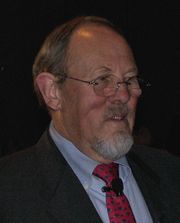وليام فورسيث شارب
وليام فورسيث شارب William F. Sharpe | |
|---|---|
 | |
| وُلِدَ | 16 يونيو 1934 |
| القومية | الولايات المتحدة |
| المدرسة الأم | جامعة كاليفورنيا، لوس أنجلس |
| عـُرِف بـ | نموذج تسعير أصول رأس المال معدل شارپ |
| الجوائز | جائزة نوبل التذكارية في العلوم الاقتصادية (1990) |
| السيرة العلمية | |
| المجالات | الاقتصاد |
| الهيئات | William F. Sharpe Associates جامعة ستانفورد جامعة كاليفورنيا في إرڤاين جامعة واشنطن 1961-68 مؤسسة راند |
| المشرف على الدكتوراه | أرمن ألچيان هاري مركويتس (غير رسمي) |
| طلاب الدكتوراه | هوارد سوسين |
ويليام فورسيث شارپ William Forsyth Sharpe (و. 16 يونيو 1934، هو أستاذ فخري في كلية ادارة الأعمال جامعة ستانفورد، وحاصل على جائزة نوبل التذكارية في العلوم الاقتصادية لعام 1999.
وكان أحد المؤسسين لنموذج تسعير أصول رأس المال، أنشأ معدل شارپ لتحليل أداء الاستثمار المعدل حسب المخاطر، ساهم في تطوير binomial method for the valuation of options, the gradient method for asset allocation optimization, and returns-based style analysis for evaluating the style and performance of investment funds.
حياته
وُلد وليام شارپ[1] في 16 يونيو 1934 في بوسطن، مساتشوستس. كان والده يعمل في الحرس الوطني، تنقلت عائلاته عدة مرات أثناء الحرب العالمية الثانية، حتى استقرت في النهاية في ريڤرسايد، كاليفورنيا. قضى شارپ بقية طفولته ومراهقته في ريڤرسايد، كما حصل على الدراسة قبل الجامعية هناك.في عام 1951 التحق بجامعة كاليفورنيا - بركلي ليتابع دراسة الطب.[2] وفي أول عام دراسي قرر أن يغير مجال دارسته وانتقل إلى جامعة كاليفورنيا، لوس أنجلس لدراسة ادارة الأعمال. وحيث كان لا تستهويه دراسة المحاسبة، فقرر التخصص في دراسة الاقتصاد. أثناء دراساته الجامعية، تأثر بإثنين من أساتذته: أرمن ألچيان، أستاذ الاقتصاد الذي أصبح معلما له، وج. فرد وتسون، أستاذ المالية وأول من عرفه على أبحاث هاري مركويتس حول نظرية المحفظة المالية portfolio theory. وفي جامعة كاليفورنيا لوس أنجلس، أصبح شارپ عضوا في أخوية بـِتا كاپا. حصل على البكالوريوس من الجامعة نفسها في عام 1955 وعلى الماجستير في عام 1956.
بعد التخرج في 1956, Sharpe joined the RAND Corporation. While doing research at RAND, he also started work for a Ph.D. at UCLA under the supervision of Armen Alchian. While searching for a dissertation topic, J. Fred Weston suggested him to ask Harry Markowitz at RAND. Working closely with Markowitz, which in practice "filled a role similar to that of dissertation advisor",[1] Sharpe earned his Ph.D. in 1961 with a thesis on a single factor model of security prices, also including an early version of the Security Market Line.
In 1961, after finishing his graduate studies, Sharpe started teaching at the جامعة واشنطن. He started research on generalizing the results in his dissertation to an equilibrium theory of asset pricing, work that yielded the Capital asset pricing model. He submitted the paper describing CAPM to the Journal of Finance in 1962. However, ironically, the paper[3] which would become one of the foundations of financial economics was initially considered irrelevant and rejected from publication. Sharpe had to wait for the editorial staff to change until finally getting the paper published in 1964.[4] At the same time, the CAPM was independently developed by John Lintner, Jan Mossin, and Jack Treynor.
In 1968, Sharpe moved to the University of California at Irvine but stayed there for only two years and, in 1970 he moved again, this time to Stanford University. While teaching at Stanford, Sharpe continued research in the field of investments, in particular on portfolio allocation and pension funds. He also became directly involved in the investment process by offering consultance to Merrill Lynch and to Wells Fargo, thus having the opportunity to put in practice the prescriptions of financial theory. In 1986, in collaboration with the Frank Russell Company, he founded Sharpe-Russell Research, a firm specialized in providing research and consultancy on asset allocation to pension funds and foundations. In 1989 he retired from teaching, retaining the position of Professor Emeritus of Finance at Stanford, choosing to focus on his consulting firm, now named William F. Sharpe Associates.
Sharpe served as a President of the American Finance Association and he is a trustee of the Economists for Peace and Security. He is also the recipient of a Doctor of Humane Letters, Honoris Causa from DePaul University, a Doctor Honoris Causa from the University of Alicante (Spain), a Doctor Honoris Causa from the University of Vienna and the UCLA Medal, UCLA's highest honor.
منشورات مختارة
أوراق بحثية
- Sharpe, William F. (1963). "A Simplified Model for Portfolio Analysis". Management Science. 9 (2): 277–93. doi:10.1287/mnsc.9.2.277.
- Sharpe, William F. (1964). "Capital Asset Prices - A Theory of Market Equilibrium Under Conditions of Risk". Journal of Finance. XIX (3): 425–42. doi:10.2307/2977928.
كتب
- Portfolio Theory and Capital Markets (McGraw-Hill, 1970 and 2000). ISBN 0071353208
- Asset Allocation Tools (Scientific Press, 1987)
- Fundamentals of Investments (with Gordon J. Alexander and Jeffrey Bailey, Prentice-Hall, 2000). ISBN 0132926172
- Investments (with Gordon J. Alexander and Jeffrey Bailey, Prentice-Hall, 1999). ISBN 0130101303
انظر أيضا
المصادر
- ^ أ ب William F. Sharpe, "Autobiography", in The Nobel Prizes 1990, Editor Tore Frängsmyr, Nobel Foundation, Stockholm, 1991
- ^ http://nobelprize.org/nobel_prizes/economics/laureates/1990/sharpe.html
- ^ Sharpe (1964) in Selected publications
- ^ Gans, Joshua S. and George B. Shepherd (1994). "How are the mighty fallen: Rejected classic articles by leading economists", The Journal of Economic Perspectives 8(1): pp. 165-79